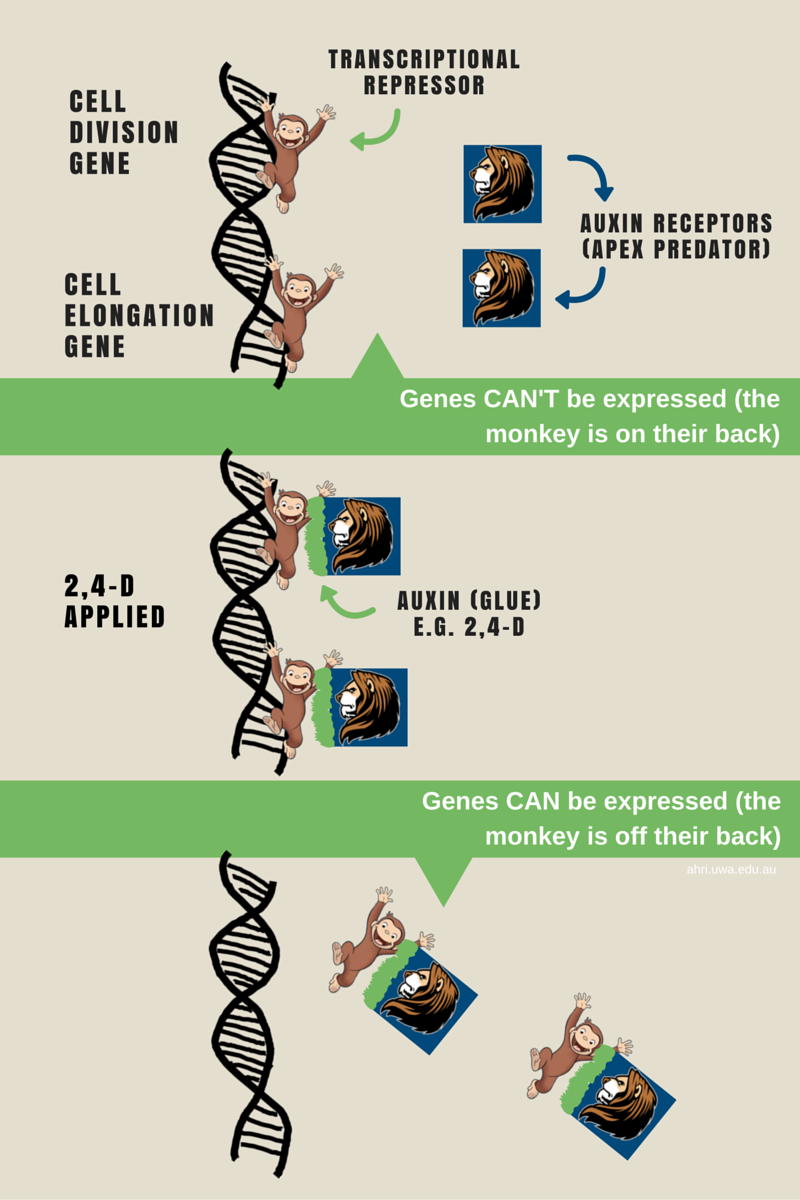May 4, 2016
It’s pretty amazing that 2,4-D is our oldest herbicide, yet scientists have only just worked out how it actually kills weeds. This has taken years of research by many researchers to understand.
So, like the monkey Curious George, we set out to understand how 2,4-D works (trust us, click through to the full post and the monkey analogy will make sense!)
2,4-D works in three stages: first, it over-stimulates plant growth; second it closes the stomata and shuts down photosynthesis. And finally, the plant eventually starves to death as it works hard to detoxify the free radicals.
In a nutshell: 2,4-D kills the plant by excessive free radicals (and all symptoms link back to this).
There’s a whole lot more to it than that. If you’d like to satisfy your curiosity of how our oldest herbicide kills weeds, keep reading!

Understanding auxins
Auxins are hormones that have many jobs, one of which is to regulate cell growth by controlling cell division and cell elongation. Plant cells need auxins to be at just the right level. Too little and plant growth is not stimulated at all. Too much auxin, and plant growth is over-stimulated.
Sports fans will be familiar with the term, the player has a ‘monkey on his back’. With the ‘monkey on their back’, they can’t win the game.
Genes often have monkeys on their back (called transcriptional repressors) which stop the gene from being expressed. Auxins stimulate plant growth by allowing an apex predator (in this case, the SCF protein complex) to eat the monkey and free the gene (#welcometothejungle). Gene expression leads to the production of proteins (enzymes) that regulate plant growth. In short, auxins can stimulate plant growth by making cell division and cell elongation happen.

How do phenoxy herbicides such as 2,4-D work?
2,4-D is a synthetic auxin. When 2,4-D is taken up by the plant, the auxin levels in the cells go through the roof. So instead of auxin being at just the right level, the auxin levels are way too high. With very high auxin levels all of the monkeys are removed from the genes (back) and all of the genes for cell elongation, cell division and hormone production are expressed all at once. At first, the plant is completely over-stimulated to grow.
This over-expression of genes does three things:
- Free radicals are produced in very high levels. What’s a free radical, we hear you ask? A free radical is a molecule with unpaired electrons. They’re unstable little beggars that cause chain reactions where the unpaired electron is passed from one molecule to the next to the next. These free radicals travel around the plant wreaking havoc wherever they go.
- Excessive ethylene is produced. Ethylene is a hormone that’s involved in fruit ripening and it causes the cells to swell up. Ethylene is also linked to extra free radical production.
- The plant closes its stomata because of the over-production of ABA (abscisic acid, a stress hormone). With the stomata closed, the plant can’t breathe in the CO2 it needs for photosynthesis. Photosynthesis stops, cutting off the food supply of the plant. Part of the process of photosynthesis involves sunlight exciting electrons. With no CO2 in the system, these electrons have got nowhere to go, so what’s produced? You guessed it, even more free radicals.
Now we have a total free radical festival going on in the plant, causing destruction at a number of levels.
Antioxidants
In humans, excessive free radicals can cause cancer. For example, UV light from the sun creates free radicals that mess with the DNA of the cell and cause skin cancer.
We’ve probably all heard the benefits of antioxidants such as vitamin C found in citrus or polyphenols found in green tea. These are health foods because the antioxidants they contain help to clean up free radicals that can cause cancer.
Plant and animal cells have built in antioxidant defence systems. These systems detoxify free radicals. This defence system is capable of cleaning up normal levels of free radicals that’s caused by normal cell growth.
However, this defence system is totally overwhelmed when 2,4-D is sprayed onto a plant and free radical levels go through the roof. In this situation, the plant ramps up the defence system (in vain) which takes a lot of energy. Unfortunately for the plant, photosynthesis has ground to a halt so it’s not getting any food and the plant starves to death. Starving to death takes time, which is why phenoxy herbicides take a long time to kill weeds.
Why do phenoxy herbicides cause twisting and curling of weeds?
The twisting and curling of leaves and stems that happens when phenoxy herbicides are sprayed onto weeds is called epinasty. This happens because free radicals interfere with a protein called actin. Actin helps the cell maintain its shape and keeps all of the organelles in the right place.

How does wheat tolerate 2,4-D and other phenoxy herbicides?
Wheat and other monocots can detoxify phenoxy herbicides. A P450 enzyme binds an oxygen molecule onto the aromatic ring structure of the herbicide. This allows a glucose molecule to bind to the herbicide, changing it so it no longer acts like a herbicide. This is a possible resistance mechanism in weeds such as wild radish but this is yet to be confirmed. See this past edition of AHRI insight for a description of how wild radish resists phenoxy herbicides through reduced translocation of the herbicide.

Conclusion
Remember: 2,4-D kills the plant by excessive free radicals (and all the symptoms link back to this).
It took a lot of scientists many years of research to work out how 2,4-D works. There is, of course, more to it than we have reported here, but this is a good summary that should satisfy the curiosity of those of us who love to know how stuff works!
P.S. Come and share your thoughts on Twitter
Follow the links below for further info:
- Past AHRI insight: 2,4-D Gridlock
Posted in: Uncategorised


